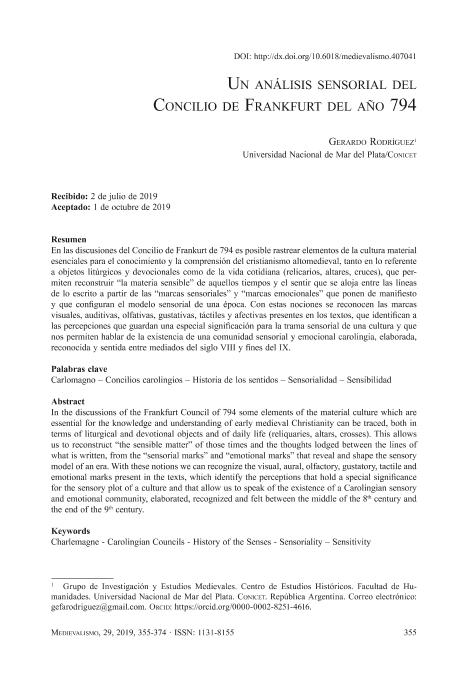Mostrar el registro sencillo del ítem
dc.contributor.author
Rodríguez, Gerardo Fabián

dc.date.available
2022-12-28T13:54:22Z
dc.date.issued
2019-12
dc.identifier.citation
Rodríguez, Gerardo Fabián; Un análisis sensorial del Concilio de Frankfurt del año 794; Universidad de Murcia; Medievalismo; 29; 12-2019; 355-374
dc.identifier.issn
1131-8155
dc.identifier.uri
http://hdl.handle.net/11336/182696
dc.description.abstract
En las discusiones del Concilio de Frankurt de 794 es posible rastrear elementos de la cultura material esenciales para el conocimiento y la comprensión del cristianismo altomedieval, tanto en lo referente a objetos litúrgicos y devocionales como de la vida cotidiana (relicarios, altares, cruces), que permiten reconstruir “la materia sensible” de aquellos tiempos y el sentir que se aloja entre las líneas de lo escrito a partir de las “marcas sensoriales” y “marcas emocionales” que ponen de manifiesto y que configuran el modelo sensorial de una época. Con estas nociones se reconocen las marcas visuales, auditivas, olfativas, gustativas, táctiles y afectivas presentes en los textos, que identifican a las percepciones que guardan una especial significación para la trama sensorial de una cultura y que nos permiten hablar de la existencia de una comunidad sensorial y emocional carolingia, elaborada, reconocida y sentida entre mediados del siglo VIII y fines del IX.
dc.description.abstract
In the discussions of the Frankfurt Council of 794 some elements of the material culture which are essential for the knowledge and understanding of early medieval Christianity can be traced, both in terms of liturgical and devotional objects and of daily life (reliquaries, altars, crosses). This allows us to reconstruct “the sensible matter” of those times and the thoughts lodged between the lines of what is written, from the “sensorial marks” and “emotional marks” that reveal and shape the sensory model of an era. With these notions we can recognize the visual, aural, olfactory, gustatory, tactile and emotional marks present in the texts, which identify the perceptions that hold a special significance for the sensory plot of a culture and that allow us to speak of the existence of a Carolingian sensory and emotional community, elaborated, recognized and felt between the middle of the 8th century and the end of the 9th century.
dc.format
application/pdf
dc.language.iso
spa
dc.publisher
Universidad de Murcia

dc.rights
info:eu-repo/semantics/openAccess
dc.rights.uri
https://creativecommons.org/licenses/by-nc-nd/2.5/ar/
dc.subject
CARLOMAGNO
dc.subject
CONCILIOS CAROLINGIOS
dc.subject
HISTORIA DE LOS SENTIDOS
dc.subject
SENSORIALIDAD
dc.subject.classification
Otras Historia y Arqueología

dc.subject.classification
Historia y Arqueología

dc.subject.classification
HUMANIDADES

dc.title
Un análisis sensorial del Concilio de Frankfurt del año 794
dc.type
info:eu-repo/semantics/article
dc.type
info:ar-repo/semantics/artículo
dc.type
info:eu-repo/semantics/publishedVersion
dc.date.updated
2022-12-27T18:10:22Z
dc.journal.number
29
dc.journal.pagination
355-374
dc.journal.pais
España

dc.journal.ciudad
Madrid
dc.description.fil
Fil: Rodríguez, Gerardo Fabián. Universidad Nacional de Mar del Plata. Facultad de Humanidades. Departamento de Historia. Centro de Estudios Históricos; Argentina. Consejo Nacional de Investigaciones Científicas y Técnicas. Centro Científico Tecnológico Conicet - Mar del Plata. Instituto de Humanidades y Ciencias Sociales. Universidad Nacional de Mar del Plata. Instituto de Humanidades y Ciencias Sociales; Argentina
dc.journal.title
Medievalismo
dc.relation.alternativeid
info:eu-repo/semantics/altIdentifier/url/https://revistas.um.es/medievalismo/article/view/407041#:~:text=En%20las%20discusiones%20del%20Concilio,altares%2C%20cruces)%2C%20que%20permiten
Archivos asociados
